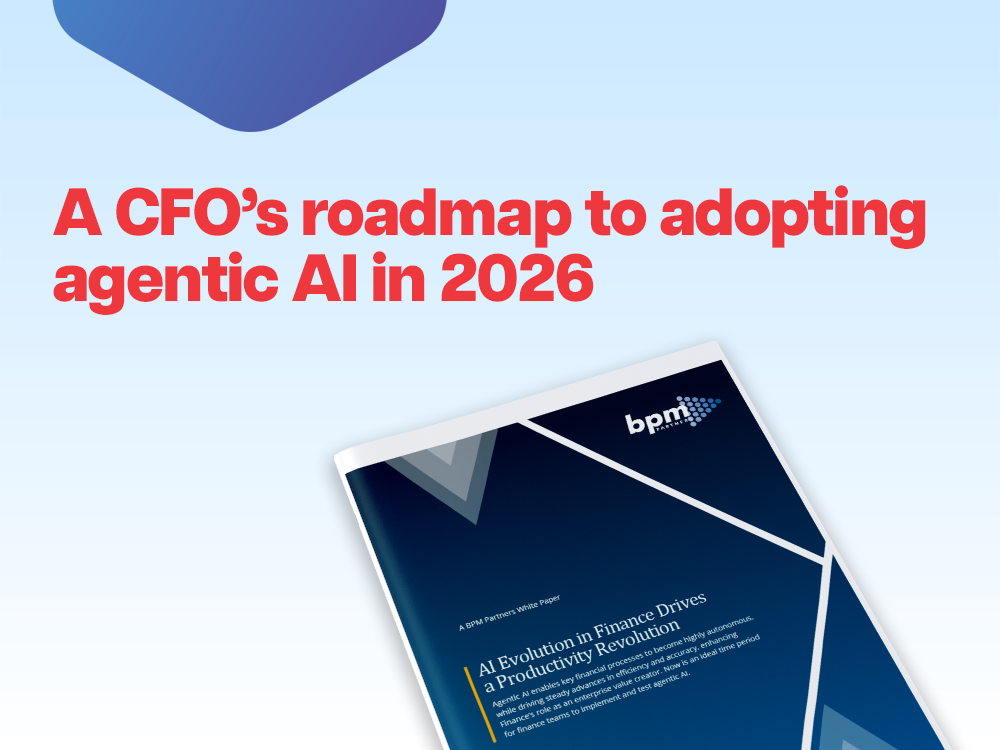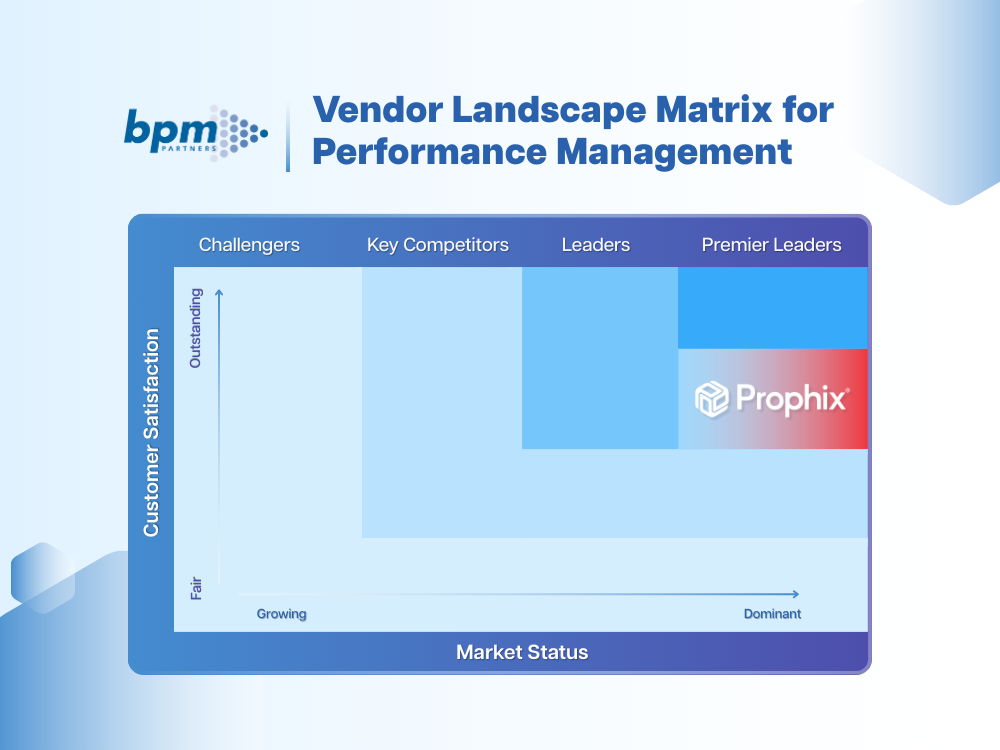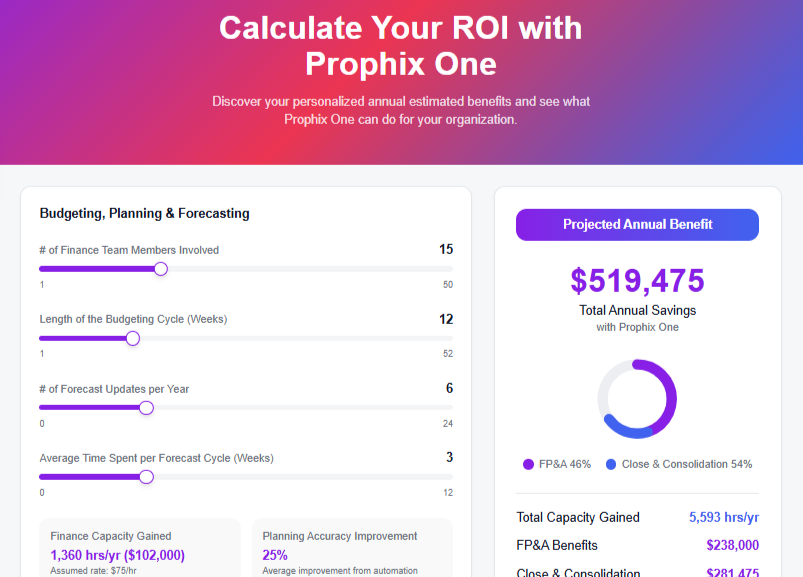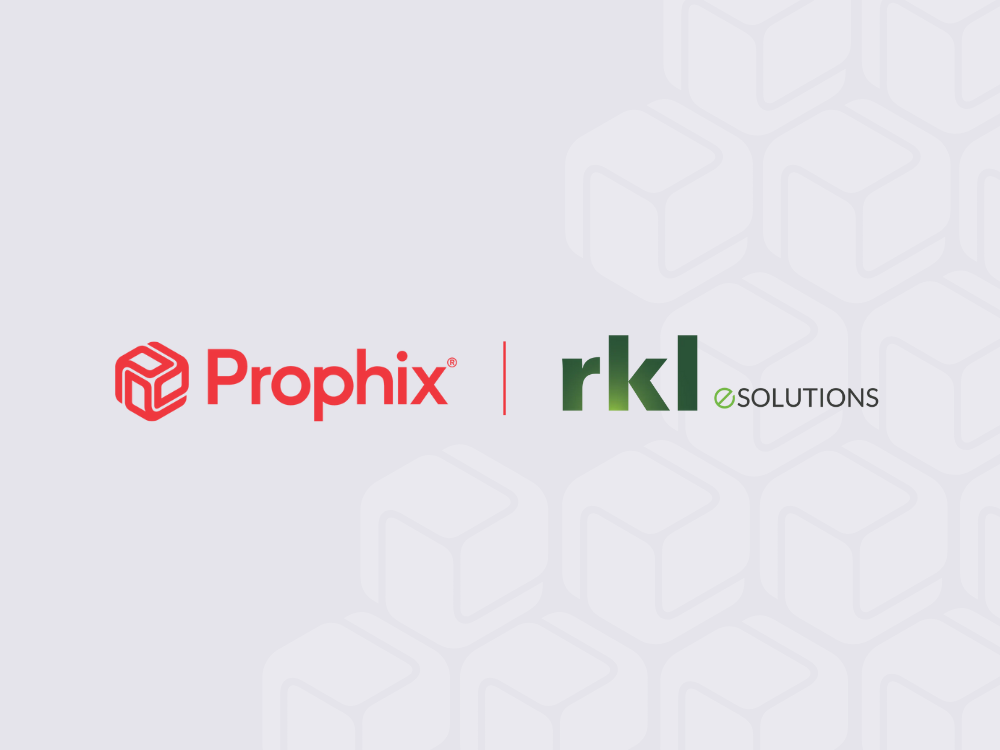Download the BPM Partners Whitepaper
9 top corporate financial planning software for 2025
Financial planning means assessing the current state of your business.
July 22, 2025Accurate financial planning requires more than spreadsheets. Today’s finance leaders need integrated FP&A tools that connect financial and operational data, support real-time reporting, and enable confident forecasting. The right solution streamlines planning, so teams can act faster, collaborate better, and make data-backed decisions that move the business forward.
What is financial planning software?
Financial planning software helps finance teams manage core tasks like budgeting, forecasting, financial analysis, and reporting. By automating financial data integration and simplifying reporting, it supports more accurate insights, faster decision-making, and streamlined planning across departments. Financial planning software helps finance teams integrate operational and financial data, automate forecasts, and improve financial performance management.
9 top midmarket financial planning software for businesses in 2025
Finance leaders need more than spreadsheets to manage growth and complexity. The top nine corporate financial planning software solutions for 2025 are built to help teams streamline budgeting, forecast with precision, and model multiple scenarios so they can plan strategically, act quickly, and drive business expansion with confidence.
1. Prophix One™, a Financial Performance Platform

Prophix One is a Financial Performance Platform that simplifies and transforms Office of the CFO processes while scaling with you. Prophix One supports key finance processes like Financial Planning & Analysis, Financial Consolidation, Account Reconciliation, Intercompany Management, and Integrated Business Planning.
Best for: Prophix One serves all teams in every industry looking for comprehensive financial planning software.
Features: Features and capabilities include data integrations, customizable workflows, dynamic reporting, predictive forecasting, and more.
Pros: Prophix One offers customer training through Prophix Academy and a dedicated support team to help you implement the platform and start seeing immediate value.
Cons: Prophix One offers more than just Financial Planning & Analysis, so you’ll need time to effectively use the platform to your advantage. Luckily, the Prophix team is ready guide you.
Integrations: Prophix One users can securely integrate data from a variety of sources into one place for key insights, reducing the reliance on IT teams. This provides a holistic view into a unified system so you can get a holistic view of your company’s performance.
Pricing: With a wide array of services and use cases, it’s best to contact the Prophix team for the most accurate quote. For more information on understanding FP&A software pricing, check out our resource.
Prophix One is the most well-rounded financial planning software on this list. Reach out for a demo to learn more about Prophix One, and how it can fit within your team.
2. Anaplan

Anaplan is a popular connected planning software tool. Aside from finance, Anaplan offers services for HR, work operations, sales, and supply chain management.
Best for: Anaplan is specifically geared toward larger mid-market companies.
Features: Some of Anaplan’s features include forecasting, dashboards, incentive management, and more.
Pros: Anaplan is easy to use and performs smoothly. The customizability is also a huge plus for users.
Cons: Anaplan’s reporting analytics are limited, and users cite difficulty when utilizing integrations.
Integrations: Anaplan supports many integration options including API integrations, third-party integrations, and their own tool called Anaplan Connect.
Pricing: There’s no free version of Anaplan, but you can contact their team for a quote.
Anaplan vs Prophix One: Prophix One offers more integration options with a broader range of functionality. Prophix One also offers a wider range of reporting analytics than Anaplan.
3. Mosaic

Mosaic is a Strategic Finance Platform made to provide a central source-of-truth for better forecasting, planning, and team alignment.
Best for: Mosaic is best for fast-growing startups hitting their mid-market stride, specifically in finance and business.
Features: Mosaic offers features like budgeting and forecasting, consolidation, performance metrics, sales metrics, and more.
Pros: Mosaic offers deep customization and simple integration with existing CRMs and accounting software.
Cons: Users cite slow performance, bugs, and long wait times for launches of key features.
Integrations: Mosaic offers integrations with a handful of popular software categories like ERPs, CRMs, and HRIS tools.
Pricing: Mosaic does offer a free trial, and you can visit their website to review plan features and request a quote.
Mosaic vs Prophix One: Mosaic is specifically developed for fast-growing startups, whereas Prophix One serves teams of all sizes in every industry. Prophix One also offers more dedicated support than Mosaic.
4. Datarails

Datarails is financial planning software for Microsoft Excel users. It automates traditionally manual processes like consolidation, reporting, and planning.
Best for: Small to medium organizations that use Microsoft Excel.
Features: Datarails features include “what if” scenarios, customizable dashboards, financial analysis, KPI monitoring, and more.
Pros: Datarails is easy to use, easy to implement, and they offer strong reporting capabilities.
Cons: There are limitations in terms of the types of dashboards users can create, as well as the amount of data users can import.
Integrations: Aside from Excel, Datarails offers over 200 integrations for popular SaaS tools.
Pricing: Datarails does not offer a free trial. You can contact their team for a quote.
Datarails vs Prophix One: Datarails is limited to companies that use Excel and has dashboard and data import limits. Prophix One is an all-in-one Financial Performance Platform that allows users to pull data from spreadsheets and other tools without having to work in them exclusively.
5. Vena

Vena is a financial planning platform that allows businesses to streamline operational, financial, and analysis processes. Vena uses an Excel interface to streamline productivity.
Best for: Vena is best for large teams specifically looking for Excel-based software.
Features: Audit trails, data integration, forecasting, multi-currency transactions, and version control.
Pros: Vena is customizable and enables teams to take away clear action items from their data.
Cons: Pricing isn’t very small-business friendly, and the implementation process for Vena can be lengthy.
Integrations: Vena offers a handful of native and partner-built connectors such as Quickbooks, Salesforce, and Dropbox.
Pricing: Vena does not offer a free trial or a free version. You can contact their team and request a quote for more information.
Vena vs Prophix One: Because Prophix One serves companies of all sizes, there are pricing options better suited for small businesses or mid-market companies than what Vena can offer. Implementation for Prophix One is also smoother.
6. OneStream

OneStream is a unified corporate performance management platform designed for enterprise-level financial consolidation, planning, and reporting.
Best for: Large enterprises needing complex financial consolidations, statutory reporting, and scalable FP&A capabilities.
Features: OneStream provides financial consolidation, budgeting, planning, predictive analytics, and compliance reporting all within a unified platform.
Pros: Strong consolidation engine, highly customizable, and robust audit and compliance capabilities.
Cons: Longer implementation times and steeper learning curve due to its complexity. Customization can require ongoing consultant support.
Integrations: OneStream integrates with ERP systems such as Oracle, SAP, Microsoft Dynamics, and Workday.
Pricing: Pricing is customized and typically geared toward large organizations. Prospective buyers must contact sales for quotes.
OneStream vs Prophix One: OneStream is powerful for enterprises with complex consolidation needs. Prophix One offers similar functionality but is faster to deploy and easier to maintain, making it ideal for mid-market to large enterprises looking for flexibility and usability.
7. Jedox

Jedox is an enterprise performance management solution focused on planning, analysis, and reporting, built on a familiar Excel interface.
Best for: Finance professionals in mid-size to large organizations that want to retain Excel-like flexibility with added automation and control.
Features: Jedox includes budgeting, forecasting, planning, and advanced modeling with AI and ML capabilities.
Pros: Excel-like interface is familiar to finance teams, and the platform is highly customizable.
Cons: Some users report performance issues with larger data sets and challenges during initial implementation.
Integrations: Jedox integrates with SAP, Oracle, Salesforce, Microsoft Dynamics, and other data sources via connectors.
Pricing: Jedox offers tiered pricing, with custom quotes available based on use case and deployment scale.
Jedox vs Prophix One: While Jedox appeals to Excel-native users, Prophix One provides a more intuitive interface with stronger built-in financial logic, streamlined workflows, and better ease of use for teams looking to reduce manual processes.
8. Planful

Planful is a cloud-based FP&A platform designed to speed up financial planning, consolidation, and reporting cycles.
Best for: Mid-market companies that want to accelerate financial close and improve agility in forecasting and reporting.
Features: Planful includes structured planning, dynamic planning, reporting, financial consolidation, and workforce planning.
Pros: Quick time to value, user-friendly interface, and strong reporting tools.
Cons: Some limitations in customization and scalability for larger or highly complex organizations.
Integrations: Planful integrates with NetSuite, Oracle, Sage Intacct, Salesforce, and other business systems.
Pricing: Planful offers custom pricing based on company size and needs.
Planful vs Prophix One: Planful is strong on ease of use and rapid deployment, but Prophix One stands out with a broader suite of features and deeper integration across the full FP&A cycle. Ideal for teams that want more strategic capability as they grow.
9. Workday Adaptive Planning

Workday Adaptive Planning is a widely adopted planning and modeling tool that helps organizations improve agility and financial decision-making.
Best for: Organizations already using Workday for HR or ERP functions and looking to extend planning capabilities.
Features: Adaptive Planning includes modeling, forecasting, reporting, dashboards, and workforce planning.
Pros: Strong visual dashboards, scalable for different company sizes, and seamless for existing Workday users.
Cons: Higher price point for non-Workday customers and less customizable outside the Workday ecosystem.
Integrations: Native integration with Workday; also integrates with other ERP, CRM, and HCM systems via APIs.
Pricing: Workday offers pricing upon request; it's generally suited to mid-size and enterprise-level businesses.
Workday Adaptive Planning vs Prophix One: While Workday Adaptive is ideal for Workday customers, Prophix One delivers more flexibility for companies using a broader tech stack. Prophix also offers stronger customer support and planning capabilities outside of workforce planning alone.
How to choose the best financial planning software for your business
Financial planning software tools can support a wide array of features for your team. Some features are best for teams with niche needs, and some are universal must-haves. Here are some must-haves to keep in mind when choosing a platform.
Evaluate the needs of your finance teams and business
Before choosing a solution, assess how your team handles financial reporting, cash flow tracking, forecasting, and scenario planning. Can they test assumptions, manage seasonal shifts, and adapt to market changes with ease? Consider whether your finance team needs more traditional CPM and FPM capabilities or a more modern, integrated platform with automation and AI.
The right software should support your company’s strategic goals, whether that’s growth, risk management, or efficiency by enabling integrated, flexible planning across departments.
Integrations
Since one of the key benefits of financial planning software is the ability to centralize data from multiple processes into one platform, you should choose one that integrates seamlessly with the systems you’re currently using.
Key functionality
Financial planning is one thing, but choosing software that encompasses all your business's financial needs will make it a much more valuable investment. Prophix One, for example, is a Financial Performance Platform where your financial planning, consolidation, account reconciliation, and other essential processes are integrated into one user-friendly platform. Financial planning, consolidation, account reconciliation, and other essential processes are integrated into one user-friendly platform.
Collaboration abilities
Ensuring your financial planning software supports inter-departmental collaboration will lessen the work of manual reporting. Collaboration capabilities should be simple, secure, and easy to use for all stakeholders.
Support and resources
Onboarding financial planning software tools can be time and resource intensive. Choose a software solution with a wealth of resources and hands-on support for the best success.
How corporate financial planning software varies by industry size
The right financial planning software isn’t one-size-fits-all. Business needs vary widely depending on size, structure, and complexity. A solution that works well for a small team may not scale to support an enterprise with global operations.
Small businesses often prioritize simplicity and ease of use. They benefit most from affordable tools that offer essential features like budgeting, financial reporting, and data security without requiring extensive setup or training.
Mid-sized organizations face growing complexity and need scalable solutions. As operations expand, so does the need for advanced revenue planning, deeper financial analysis, stronger integrations across departments, and more robust security.
Large enterprises demand enterprise-grade software. These teams manage multiple entities, currencies, and regions, and require advanced FP&A capabilities, predictive analytics, and a high level of customization that supports enterprise performance management. Integrated operational and financial data is essential for company-wide visibility and planning.
Understanding how needs differ by company size helps finance leaders choose the right platform for their teams. One that meets current demands while supporting future growth and agility.
For more insights on aligning finance with operations, check out our integrated business planning guide.
Benefits of financial planning software
Some companies—especially smaller ones—may opt for a more manual approach to financial planning. While that may seem simple, it’s not scalable and will lead to complications as your business grows. Let’s take a look at the top three benefits of implementing financial planning software.
Centralization
You may have different dashboards and data silos for each department. Manually sifting through and organizing this data can be tedious. FP&A software will aggregate data in one place for simple analysis.
Easier collaboration
With financial planning software, updates don’t get lost in email chains or messaging apps. It’s not just your data that’s centralized, but all the tasks involved in financial planning will be in one place, too.
Streamlined processes
Centralizing your financial planning process in a single platform simplifies data management, enhances accuracy, and improves collaboration across teams, enabling more strategic decision-making and forecasting.
Conclusion: How financial planning software drives better business performance
Modern financial planning software helps finance leaders move beyond manual processes and disconnected spreadsheets. By integrating data, automating workflows, and enabling scenario modeling, these tools give teams the clarity and agility needed to plan effectively and act with confidence.
With the right platform, finance teams can:
Streamline and automate budgeting, forecasting, and reporting
Run multiple what-if scenarios to prepare for change
Break down silos and drive cross-functional collaboration
Enable data-driven, strategic decision-making that fuels business growth
This kind of unified performance management helps finance leaders make faster, more confident decisions.
Ready to see what you can do with Prophix One™?
Insights for next-gen finance leaders
Stay ahead with actionable finance strategies, tips, news, and trends.





